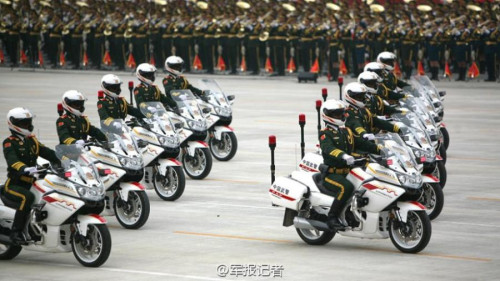
Established for just a year, Chinese armed police motorcycle guard formation will make its debut on the V-Day Parade that will be held on Sep. 3 in Beijing. Let's have a look at of a group of training photos of the formation.(Photo/81.cn)
Chinese troops won their war against Japanese aggression 70 years ago after fighting against one of the most technologically advanced powers of the time.[Special coverage]
But when the veterans parade through central Beijing this week to mark the anniversary, they will be guided by one of the world's most advanced global satellite navigation systems.
China's self-developed Beidou system will facilitate the parade from space, marking its first deployment for a military parade.
When China held its last military parade for the 60th National Day in 2009, Beidou only had three satellites operating. But for the 70th anniversary of the end of World War II on Sept. 3, Beidou will have almost 20 satellites.
Yang Hui, a Beidou chief designer, says supervision of the parade will be easier and more efficient thanks to Beidou's high precision, accurate positioning and its navigation and timing functions.
Wang Shun, Deputy Chief of Staff of Beijing military district, said at a recent news conference that the parade rehearsals employed Beidou's high-precision positioning and measuring technology.
"These technologies have greatly improved the quality and efficiency of the rehearsals," says Yang Hui.
Unlike GPS, Beidou users can report their positions. This special feature was a lucky result of a lack of funds during development of Beidou's first generation system.
Positioning and navigation required two satellites and computation by the ground station. A user needed to send a position request to the ground station through the satellites to know their location. As a result, the ground station can also locate the user, while GPS cannot. "The merit of GPS is keeping your position a secret," Yang says.
Today, users of the second generation of Beidou navigation system can choose whether to keep their position a secret. The function of reporting a user's position has assisted the military parade organization.
The parade will comprise around 12,000 people in 50 formations. "It's impossible to coordinate the parade solely with spoken orders. However, if everyone is equipped with a Beidou navigator, their position can be projected onto a screen for the commanders to see and guide."
China began to build the Beidou satellite navigation system in 1994, two decades after the United States developed GPS.
The construction of the Beidou satellite navigation system has a "three-step strategy": first the building of the experimental navigation satellite system by 2000; second the building of the regional navigation system by 2012; and third enabling the system to cover every corner of the globe by 2020.
China has achieved the first two steps, becoming the third country to have an independent satellite navigation and positioning system after the U.S. and Russia.
The positioning precision of Beidou navigation satellite has reached centimeter-level, with the help of ground-based facilities. "The next generation of Beidou will rival the next generation of GPS in terms of precision," says Yang.
The 18th and 19th Beidou satellites, launched on July 25, have set up an inter-satellite link, realizing communication and distance measurement among satellites. The two new satellites surpass their predecessors in speed, accuracy and weight. They also have intelligent autonomous operation.
Beidou has played an important role on many occasions. After the 2008 Sichuan earthquake, it was used to transmit information to the emergency command when other telecommunications failed.
Its use now extends to industries like transport, marine fisheries, weather forecasting, hydrological monitoring, surveying and mapping, as well as to smart phones and car navigation.
Beidou satellite navigation has also has been introduced into ASEAN countries such as Laos, Brunei and Pakistan.


















































